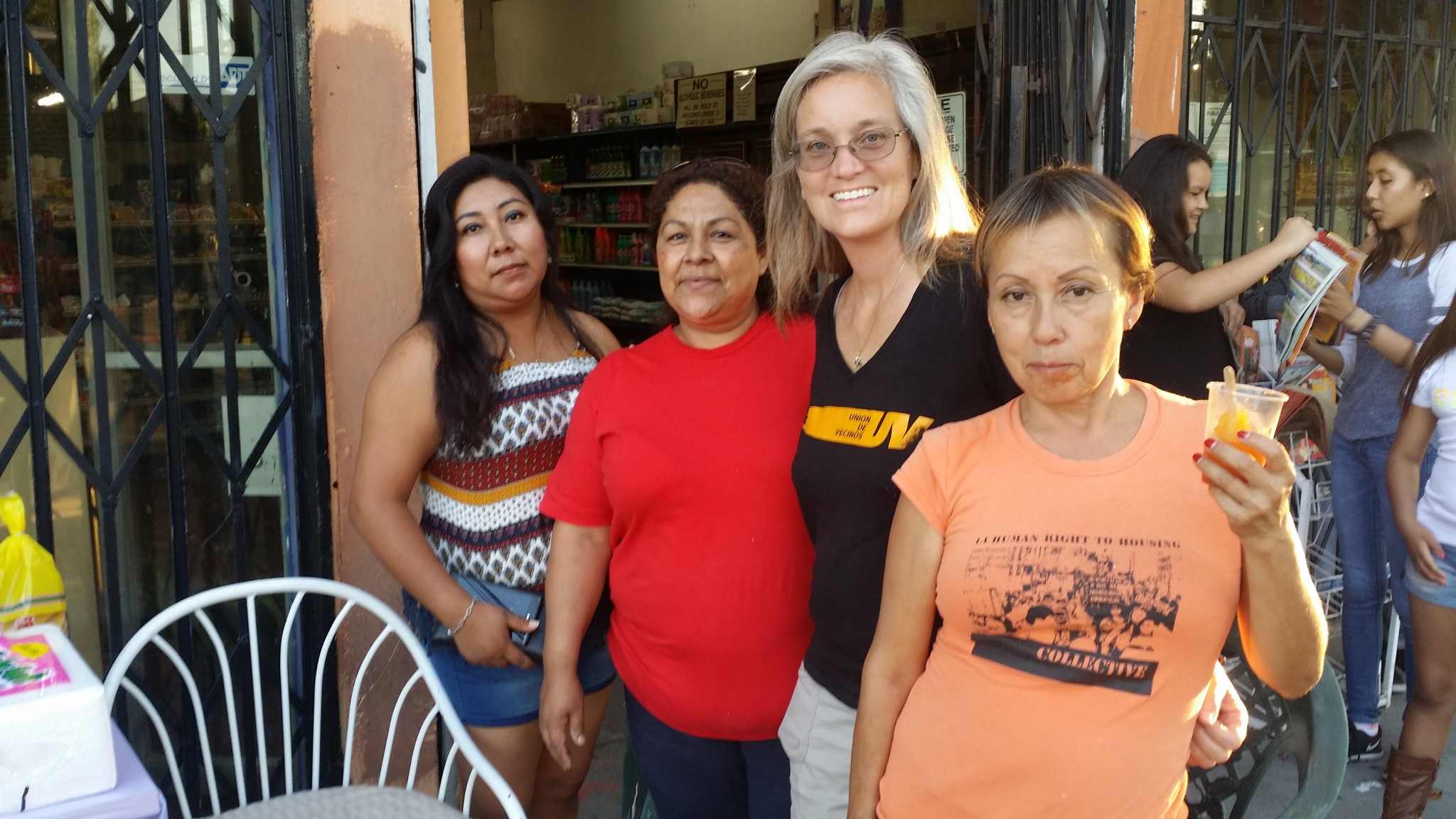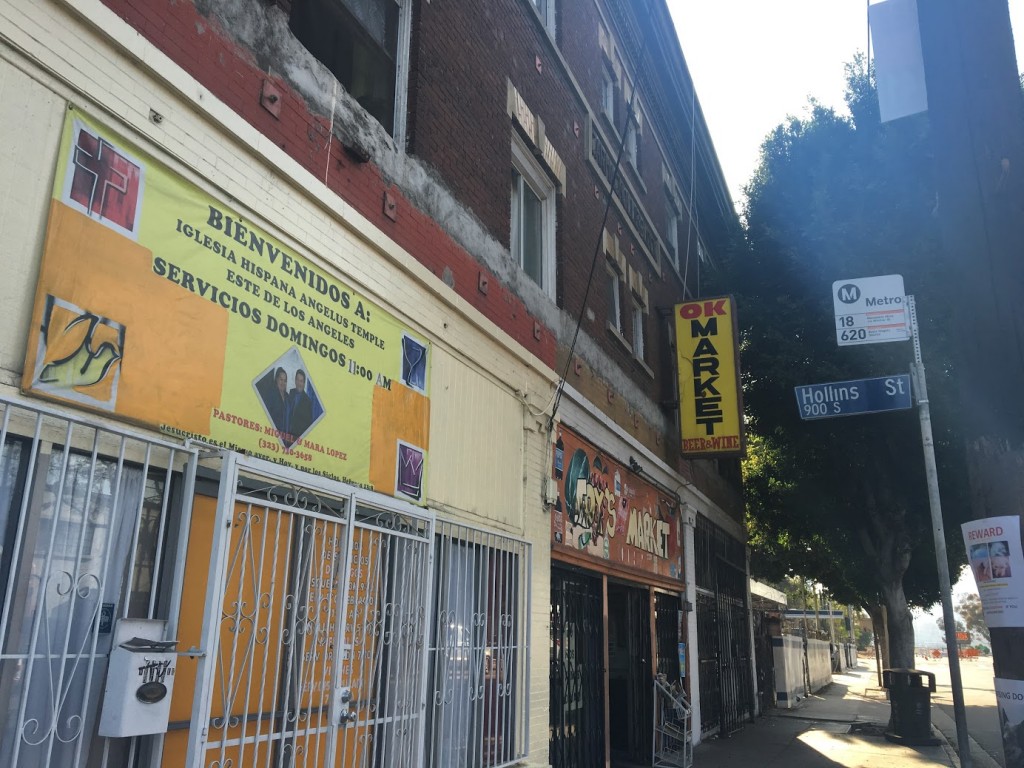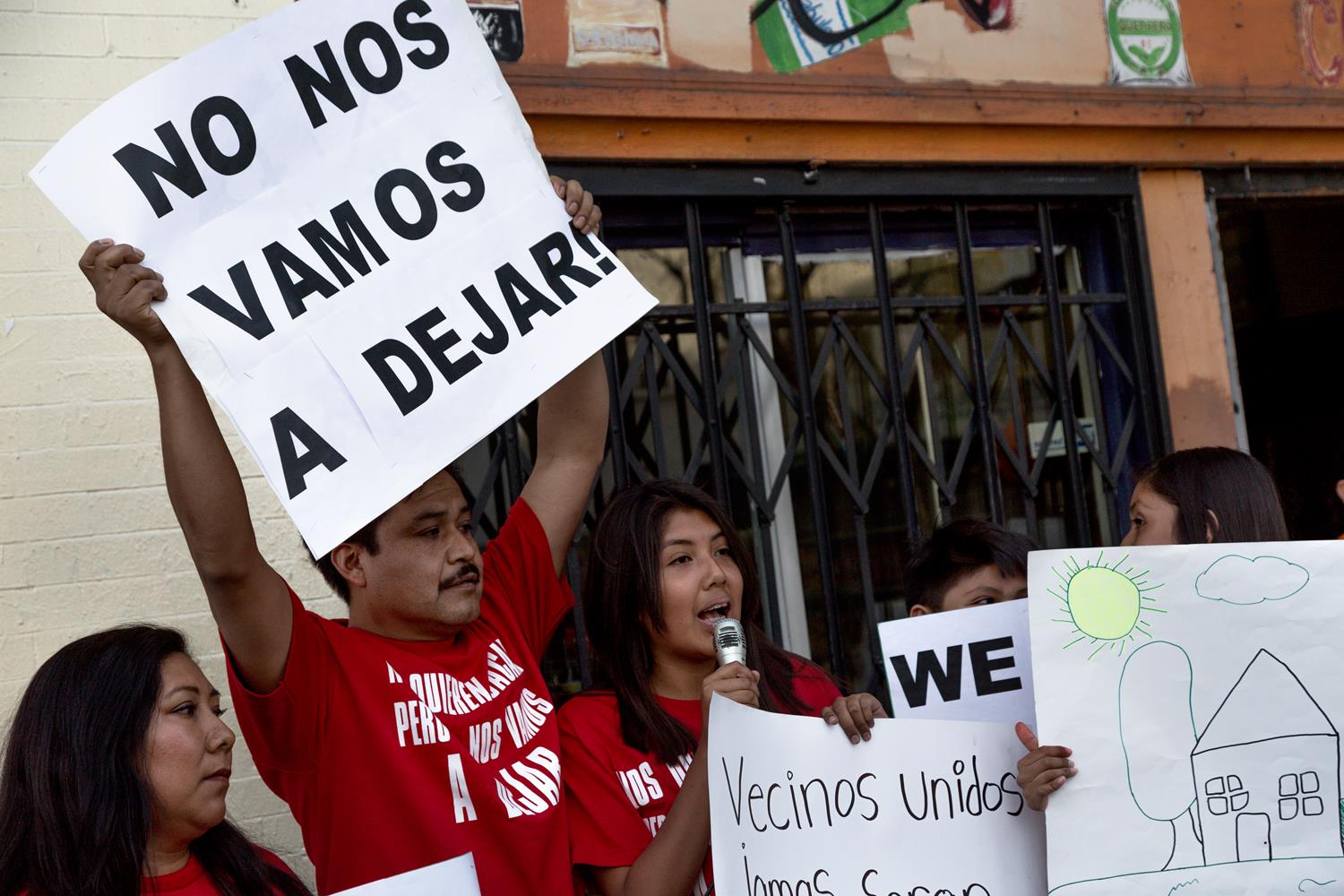In Boyle Heights, the signs of gentrification are everywhere

With housing prices climbing ever higher in Los Angeles, most low-income neighborhoods are on gentrification watch. That is certainly the case in Boyle Heights, the mostly Latino, mostly low-income neighborhood just east of Downtown LA.
The signs of gentrification are everywhere in Boyle Heights: first-time homeowners who moved from other parts of the city, a bunch of new art galleries, complaints of rapacious landlords kicking out low-income tenants and activists fighting back.
I recently spent time in Boyle Heights talking to both people moving into the neighborhood and people fighting to stay.
Kevin Barney is 47, and he recently purchased his very first home in Boyle Heights. It’s a small yellow bungalow, and Barney snapped it up for $310,000 (the median home price in the city is $580,000). You can just see the top of the downtown skyline from the front yard of the the two bedroom house.
Barney, who works on USC’s Health Sciences Campus in East LA, moved to Boyle Heights to be closer to his job. But he’s gotten a lot more from the neighborhood than its convenient location.
“The noise here is awesome. They have roosters, they have roosters,†he says, pointing to his neighbors’ houses. “Sometimes the roosters go at each other like in a vocal contest. And then there’s the Catholic church right there and they ring the bells. Then we get all the ice cream trucks.â€
Barney likes Boyle Heights the way it is now. And so he doesn’t quite know how to feel about the fact that he is a gentrifier.
“I don’t want tons of people to follow me. I’m a runner so I go running down Cesar Chavez and I haven’t seen a single franchise. There’s no McDonalds, there’s no Starbucks. And I love that. I hope it doesn’t really change.â€
But Boyle Heights is changing. Fast.

Elizabeth Blaney with community members and a member of Union de Veicnos, Teresa Alfaro. Courtesy: Elizabeth Blaney
The Activist
On a recent afternoon in Boyle Heights, affordable housing advocate Elizabeth Blaney gave me a 360 view of gentrification in the neighborhood. Literally.
On a nondescript street corner near the freeway, Blaney points out the tower of an old, Art Deco Sears Department store, and tells me that the building will soon be market-rate, luxury apartments. Then, she points down the street to a taco shack called Tacos Michoacan.
“It’s been here 45 years; it’s a 24-hour taco place. They are now moving and we’ve been told it’ll either be a Panda Express or a Starbucks. And then two blocks down a 7-11 is supposed to be coming in.â€
Blaney, co-director of the nonprofit advocacy group Union de Vecinos, admits that change in Boyle Heights is inevitable. After all, the neighborhood was a largely Jewish enclave before it became majority Latino in the later half of the 20th century.
But she says there are ways to mitigate the damage done to low-income renters as the change accelerates. “There should be investment in people who are currently living here, and the types of services that should be here are ones that meet the needs of community residents. Nobody’s asking for a Panda Express or a 7-11.â€
And so Blaney is fighting on behalf of residents and business owners that she says are being unfairly squeezed out by landlords to make room for an influx of gentrifiers.
Elvira Barrales, her husband and four children have lived in a one-bedroom apartment above a small market in Boyle Heights for 16 years. Vacant units in the same building are currently renting for around $1,200 a month. Barrales pays $633 a month. Which is why, she says, her family received an eviction notice this spring. (Landlord Brian Neman of Hyde Property Management was repeatedly contacted to comment on this story but never responded.)
The landlord told Barrales that she and her husband were violating their lease agreement because they hadn’t listed their two youngest children on the lease when they rented the apartment. But those children weren’t born yet when they first moved in to the apartment.
Barrales decided to fight the eviction. And she won. But the battle was incredibly stressful, time consuming and resource intensive. Housing advocate Elizabeth Blaney translates Barrales’ Spanish for me.
“So she was feeling very, very sad because her 15-year-old turned 15, so the [quinceanera] that they had planned they had to cancel,†Blaney translates. I ask if they’ll have the quinceanera now that their home is safe.
Barrales gets emotional as she relates to Blaney: “They postponed it to the next year, but her daughter doesn’t want it now. So…â€
If Barrales and her family lose their apartment in the future, there isn’t really anywhere for them to go, says Blaney. The family brings in about $20,000 a year in income. Too much for housing set aside for the most destitute (often homeless) Angelenos, but too little to afford market-rate apartments.
“Even with the affordable housing being built in different parts of the city, there tends to be very few units built at extremely low-income levels, and more units built at higher income levels, around 50 or 60 thousand, which some would consider low-income. But in this neighborhood, that’s considered high income.†In other words, even the “affordable†housing in Los Angeles is out of reach for many families.
The Barrales family, like many other low-income Latino families, is in danger of slipping through the cracks caused by gentrification in Boyle Heights, she says.
The Future
Back at Kevin Barney’s little yellow bungalow, his real estate agent, Rose Garcia, is doing the math. “We purchased this home for 310 [thousand dollars]. And now it’s worth over 425,†Garcia says. That’s a jump in $115,000 since February, when Kevin bought the house.
“And all I’ve done is painted one closet,†Barney adds, marveling at his return on investment.
For longtime homeowners in Boyle Heights, the math looks even better, Garcia says. “These are Hispanic people that have owned these homes for 20, 30 years. I mean, not for nothing, let’s be honest, they’re cashing in. That’s what they’re doing.â€
Garcia is also Hispanic, and she grew up in another Los Angeles neighborhood that’s been through the gentrification gauntlet: Highland Park. So what’s happening in Boyle Heights looks very familiar to her.
“I always say I used to dodge bullets, now I dodge hipsters. Do I think it’s changing for the better? Yes, because it’s multicultural. That’s what we’re about. You have everything. Perfect example, my neighbors Jeff and Nona, they’re caucasian in Highland Park. They’ve lived next to us for over 15 years. They have small children that are in a bilingual program in our neighborhood. OUR neighborhood.â€
That multiculturalism is what helps draw many, including Kevin Barney, to gentrifying neighborhoods at first. But after awhile, there seems to be a tipping point, I put to Garcia. That neighborhoods like Silver Lake and Echo Park are now unaffordable for most working class Latinos. That many businesses have shut down and it’s a bunch of rich, white people who can afford to live in those neighborhoods.
Garcia admits that gentrification certainly has its downsides, despite the money she’s making as a real estate agent in changing neighborhoods.
She offers this example from her native Highland Park: “My mother’s favorite jeweler, Elmer. We go to Elmer’s jewelry since we were kids. We’re Catholic so we get our little bracelets for the kids there. Elmer, I was fixing a watch, and he said you need to pick it up, I’m closing on Friday. He’s been there for like over 25 years. I’m like what are you talking about? He goes they raised my rent from $1,500 to $6,000. You kind of have to figure out where it’s fair and I think when it comes to the commercial side of it it’s not. The residential side of it is. So you know.â€
I ask her how you prevent that kind of situation from happening in Boyle Heights.
“You can’t.â€
Press Play producer Anna Scott co-reported this story


